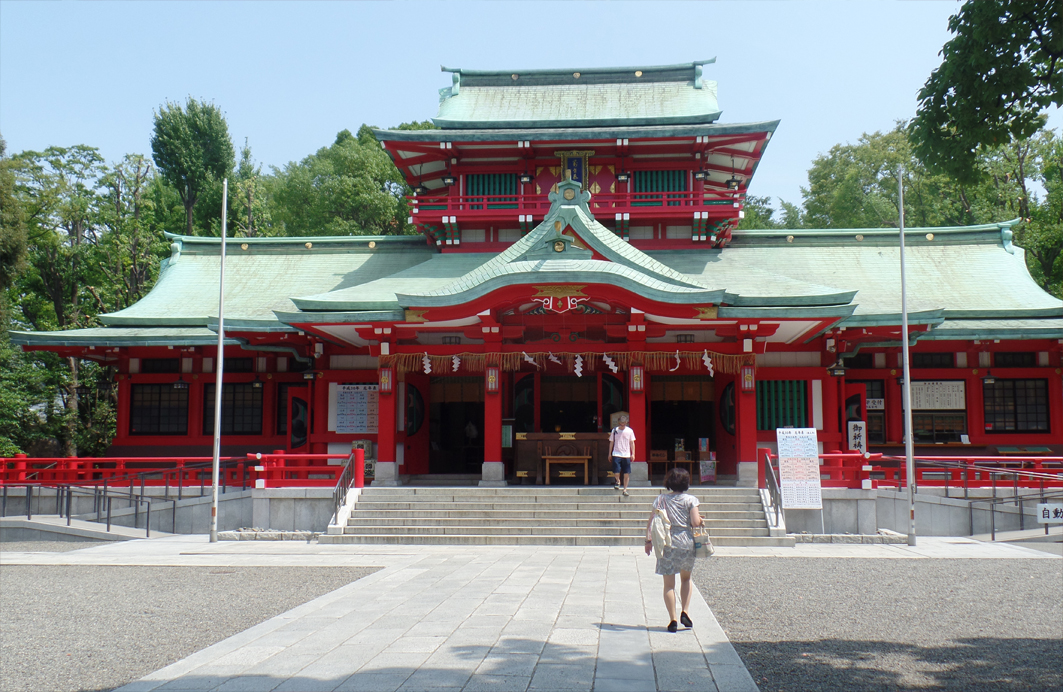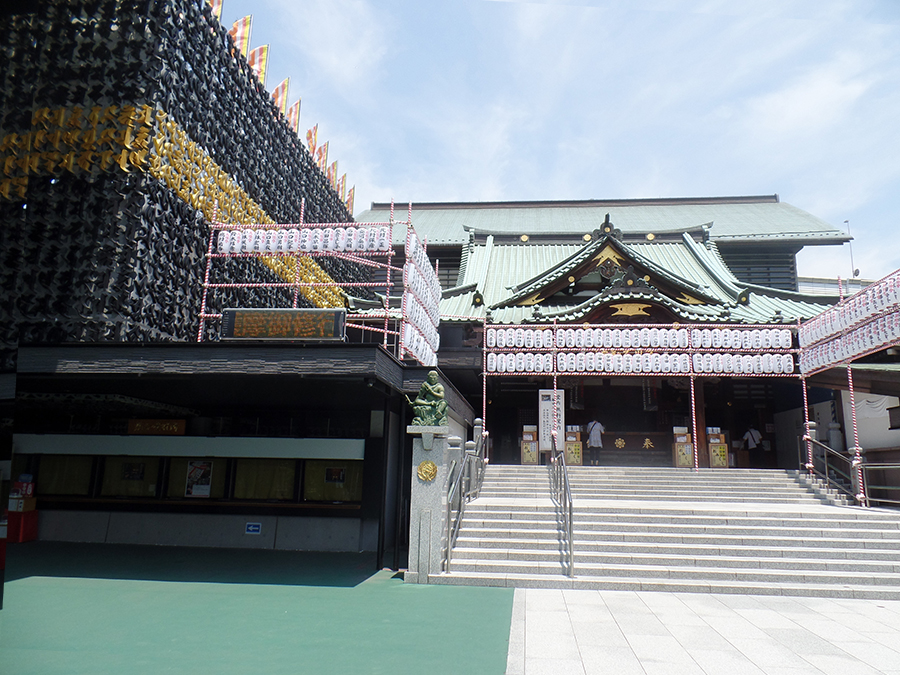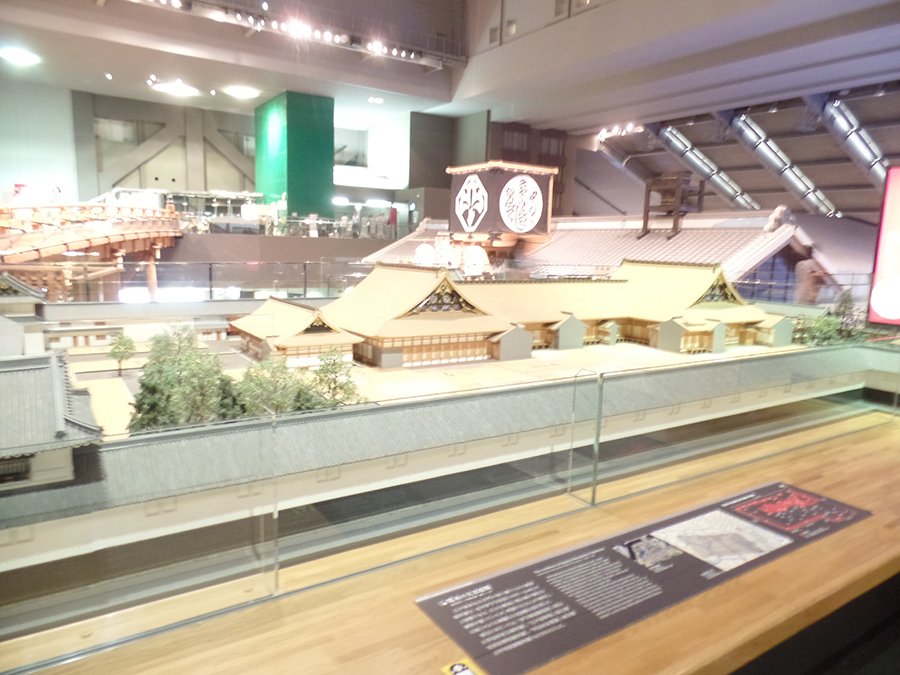We arrived at Narita airport and went straight to the bright red bannered JR East Travel Service Center to purchase tickets on the Narita Express (N’EX) train to Tokyo Station. The staff at JR (which I believe stands for Japan Rail) was fluent in English and provided excellent service, answering our questions and ensuring we had the right tickets to reserve seats, be on a train we could next make and knew what train we needed in order to arrive back at the airport for our next flight.
When we arrived at Tokyo station we stopped to look for signs that would identify where we needed to go to leave the station. A pleasant young woman in a green shirt wearing a logo of Tokyo Station Information was able to provide us with a map of the station and marked directions on how to find our hotel (The Shangri-La) which is adjacent to the station.
Check in at the hotel was speedy and the staff very knowledgeable and friendly. We asked a question about a possible restaurant we were interested in. While they did not have the information readily at hand, they were back at the room within fifteen minutes with maps, directions and approximate time to reach it in a taxi.
Tired from the long flight we chose not to venture out for dinner, but rather ate a light dinner at the hotel lobby bar, which consisted of falafel and hummus, chicken satay and a modified rice and seafood dish to eliminate soy.
The Shangri-La rooms are large, well-appointed and have all the latest in Japanese home wizardry including multiple lowering window shades, a toilet with a seat that raises electrically, senses your presence and is also heated. It has a built in bidet so it will do everything for you except wipe. The shower has a window into the bedroom and a rain shower head in a room that includes the bathtub. We found the staff fluent, friendly and respectful. They went out of their way to assist us with answers to the many questions we had, provide maps and arrange taxis to take us to and return from the Geisha performance we had booked prior to our arrival.
After a full night of sleep we had breakfast at the hotel where we had an Acai Greek Yogurt Bowl and Buckwheat Pancakes with unusual combinations of flavors. They also served an extensive buffet, but we simply weren’t that hungry. We then met with Masumi ‘Sue’ Sugiura from Tokyo Free Guide service. (www.TokyoFreeGuide.co.jp) Sue was volunteering to take us around the city on her day off. Her commute to find us at our hotel was over an hour. We found Sue to be very pleasant, knowledgeable of Tokyo and many things, and fluent in English having lived in the US for four years.
Sue insisted in showing us how to find our way around Tokyo on the subway and trains and made what seemed an indecipherable maze into an understandable means of getting around. Given there are multiple different train companies in Tokyo, we bought one-way tickets at each station since a day pass on one line would not take us where we wanted to go easily. She also showed us how we could add money to our ticket if it was not enough to get home at a Fare Recharge machine near the gates and how the ticket does not come back up from the turnstile after completing your ride final ride.
Sue gave us a copy of the Tokyo Travel Guide which is available from the Tokyo Convention and Visitors Bureau. (www.tcvb.or.jp/en/) This indispensable guide profiles the major attractions and places to visit giving admission fees, address, and access by train or subway including the stop nearest and hours and days of operation. The guide also enables some discounts at various attractions.
We took the train from Tokyo Station to Monzen-nakacho. Our first stop was a Shinto shrine – Tomioka Hachimangu (I Chome-20-3 Tomioka Koto, Tokyo 135-0047). This shrine is the largest Hachiman shrine in Tokyo. Sue explained that Shinto was the original religion of Japan, but in the sixth century Buddhism was established as a companion religion. She explained that it has been a companion religion because Shinto focuses on the living and Buddhism the afterlife. Apparently births and weddings are celebrated at the Shinto Shrines and burials at the Buddhist temples. She said there has never been a conflict between the two religions and often a Shinto shrine exists on the same property as a Buddhist Temple. She mentioned there are a number of ‘one-day Christians’ who are the women who wish to wear a white dress at their weddings.

Shinto Shrine in Tokyo
At the shrine we cleansed ourselves as is the custom, made our donations and viewed the shrine. Sue explained that you can buy a fortune at the shrine and if it is not a fortunate fortune you can tie it on a wire outside the shrine. Approximately 30% of the fortunes are not fortunate.
We made our way from the shrine to a monument to the Sumo wrestling champions of Tokyo where the names of the most famous have been carved in stone.
From there we walked the short distance to a Buddhist temple dedicated to the fire god Fukagawa Fudodo (1 Chome-18-17 13 Tomioka Koto Tokyo 135-0047). At this temple we witnessed probably the most spectacular event of our trip: the Fire Ritual. This ritual takes about 30 minutes and includes a blessing for those who wish to participate. The blessing is for a handbag or briefcase or cell-phone or computer which is held over the fire for a brief moment. I hope you like the pictures in this blog as my camera was blessed in this event.

Buddhist Temple in Tokyo
I found the ceremony fascinating and apparently the temple we attended is the only one in Tokyo that performs this particular ritual, which includes fire, drums and chanting throughout. Sue confirmed that the monks spoke in Japanese, although the chats were in a Buddhist language she only partially understood.
From the Fire Ceremony we walked directly out of the temple and went up the street that runs into the temple and had a traditional Japanese breakfast for lunch at Kintame restaurant which is on the right side. I did not get an address for this location. Sue said this was her favorite restaurant in this area and explained that she likes it because they serve a Japanese traditional breakfast at lunch. The meal included cooked marinated fish, miso soup, rice, and a couple side dishes, along with broiled green tea and fresh pickled vegetables. This is seldom served today as people have adopted a faster lifestyle that includes a lighter breakfast. Many people in Japan still go to restaurants like the one we visited for lunch in order to have the traditional breakfast they seldom enjoy. The clientele was distinctively older Japanese who apparently share Sue’s desire to have a familiar but not so often served meal.
From lunch we were scheduled to go to Kiyosumi Gardens, however, it was mid ninety degrees with high humidity so instead we opted for an indoor venue: The Edo-Tokyo museum (1-4-1 Yokoami, Sumida-ku located at the Ryogoku station on the JR train or subway stop E-12). Sue informed us that in 1603 the Shogun moved the capital from Kyoto to Edo, which would become Tokyo after the Shogun period ended in the late 1800s. There was no war in Japan during the Shogun period because the Shogun kept his potential adversaries on a short leash. All 300 Kings of the Japanese provinces were forced to live in Edo for one year and then return to their kingdoms for one year. They were also forced to bring their Samurai with them. The various kings had between 100 and 3,000 Samurai. So every year a whole lot of people were moving back and forth. This was very expensive and kept the kings from being able to make or buy weapons, thus keeping them weak.

Edo Museum in Tokyo
We also learned how human feces were sold to farmers from the people in Edo (Tokyo) to help crops grow and that the richer one was the more desirable the feces and the higher the price paid. Because feces were valued it never ended up in the streets and explains why disease was not as rampant in Japan as in Europe during the same eras.
Sue explained an interesting fact about Geishas and Kabuki dancers. The Geishas and main dancers wore white makeup on their faces because the theaters where they performed were only lit by candles. The white makeup made it easier to see the expression on the faces of the performers in the dimly lit stages.
The museum was fascinating in that it had many models of what Edo was like as it grew into the economic center of Japan. This visit changed completely my conception of what Japan was like prior to the opening to the west in the late 1800s. Sue discussed why Japanese homes of this era were made of wood and paper. The heat and humidity prevalent in much of Japan resulted in mold in most closed buildings. Therefore light and airy structures were found to prevent the growth of mold and more acceptable for living spaces. However, such structures were subject to fires. As a result Japan was the first nation to establish ‘Fire Brigades’ to deal with the fires. Many communities also had volunteer or paid fire watchers who would sound alarms to rush to contain the many fires that occurred. Pictures show the firemen with pike like rods that were used to pull the wooden structures down to establish a fire break as once a building went up in flames it was nearly impossible to stop the spread by any other means. The firemen were also amongst the first to have tattoos. The reason for the tattoos was to enable authorities to identify bodies of various firemen who were severely burned beyond recognition in many cases.
Sue pointed out to us that a portion of the place had a copper roof. These were the only buildings the Shogun would visit as the metal roof was essentially fire retardant. The Shogun would not expose himself to being caught unawares of a fire in a wooden building because the fires could spread so quickly that the Shogun could get trapped and die in a wooden structure.
We were scheduled to visit the Sensoji Temple and Asakusa, but the extreme heat caused us to call it a day.
Sue returned with us to Tokyo Station to be sure we could find our way back to our hotel where we said good-bye, having a much greater appreciation for life in modern Tokyo, the predominant religions and how they complement each other, and the history of this city and the nation as a whole from 1603 to the opening to the west. We also realized that there is a tremendous range of interesting places to visit, which means we barely scratched the surface of this fascinating city.





No Comments